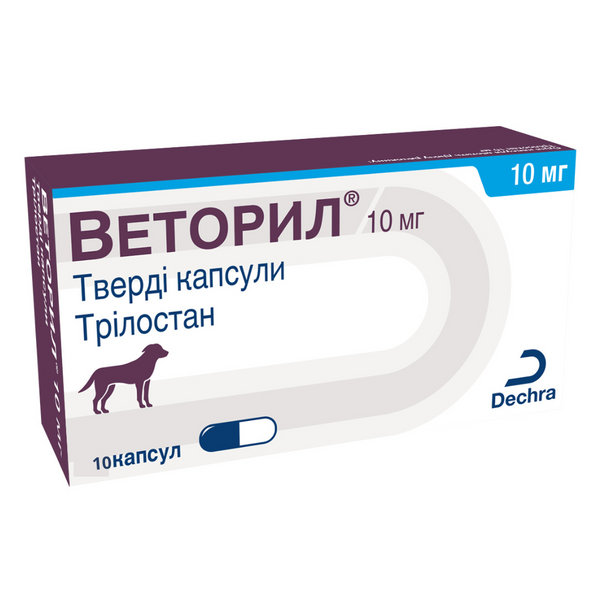|
Quantity
|
Out of stock
|
||
|
|
|||
Composition
One capsule contains the active substance:
Trilostane 10 mg.
Excipients: titanium dioxide (E171) 0.942 mg, yellow iron oxide (E172) 0.035 mg, black iron oxide (E172) 0.532 mg, corn starch, lactose monohydrate, magnesium stearate, gluten.
Pharmaceutical form
Hard capsules.
Pharmacological properties
Pharmacotherapeutic group: antiadrenal drugs.
ATCvet code: QH02CA01 trilostane.
Pharmacodynamic properties
Trilostane selectively and reversibly inhibits the 3 beta hydroxysteroid isomerase enzyme system, thereby blocking the production of cortisol, corticosterone and aldosterone. In the treatment of hyperadrenocorticism, trilostane reduces the production of glucocorticoid and mineralocorticoid steroids in the adrenal cortex. Thus, the circulating concentration of these steroids is reduced. Trilostane also inhibits the action of exogenous ACTH (ACTH) and has no direct effect on either the central nervous system or the cardiovascular system.
Pharmacokinetic properties
Pharmacokinetic studies in dogs have demonstrated high interindividual variability. In a pharmacokinetic study in beagles, the area under the curve ranged from 52 to 281 μg/mL/min in fed dogs and from 16 to 175 μg/mL/min in fasted dogs. In general, trilostane is rapidly cleared from plasma, reaching peak concentrations between 0.5 and 2.5 hours and returning to near baseline levels six to twelve hours after administration. The primary active metabolite of trilostane, ketotrilostane, follows a similar pattern. There is no evidence of accumulation of trilostane or metabolites over time. Oral bioavailability studies have shown that trilostane is absorbed to a greater extent when administered with food. Studies have shown that trilostane is eliminated primarily in the feces in the rat, demonstrating biliary excretion as the major metabolic pathway. In the monkey, trilostane is eliminated in equal amounts in the feces and urine. Results show that trilostane is rapidly and well absorbed from the gastrointestinal tract in both rats and monkeys and accumulates in the rat adrenal gland.
Species
Dogs.
Indications, Target Species
For the treatment of pituitary and adrenal hyperadrenocorticism (Cushing's disease and syndrome) in dogs.
Contraindications
Do not administer to animals with primary liver disease and/or renal failure, or in cases of hypersensitivity to the active substance or to any of the excipients.
Do not administer to dogs weighing less than 3 kg.
Adverse reactions
Corticosteroid withdrawal syndrome or hypocortisolemia should be differentiated from hypoadrenocorticism by measuring serum electrolytes. Signs associated with iatrogenic hypoadrenocorticism may be observed, including weakness, lethargy, anorexia, vomiting, diarrhea, ataxia, increased salivation, bloating, tremors, skin changes, and acute addisonic crisis (collapse). These signs usually resolve upon discontinuation of treatment. In the absence of evidence of hypoadrenocortisism, dogs may present with lethargy, vomiting, diarrhea, and anorexia. In exceptional cases, treatment of dogs, adrenal necrosis has been reported, which may lead to hypoadrenocorticism. Subclinical renal dysfunction may be detected during treatment. Arthritis may also occur during treatment due to a decrease in the internal level of corticosteroids.
Special warnings for each animal species
Unknown.
Special warnings for use
Special warnings for use in animals.
Since hyperadrenocorticism is diagnosed in most cases in dogs aged 10 to 15 years, other pathological processes are often encountered. It is especially important to monitor cases of primary liver disease and renal failure, since the drug is contraindicated in these diseases. Diagnostics should be carried out during treatment, monitoring liver enzymes, electrolytes, urea and creatinine. The presence of diabetes mellitus and hyperadrenocorticism requires special diagnostics. Adrenal function is reduced if the dog has previously been treated with mitotane. The interval before using trilostane is one month. A thorough adrenal function assessment is recommended as dogs may be more sensitive to the effects of trilostane. The drug should be used with caution in dogs suffering from anemia as cell mass and hemoglobin may decrease. Regular monitoring is recommended.
Use during pregnancy, lactation and egg production
Do not use in any pregnant or lactating animal intended for breeding.
Interaction with other drugs and other forms of interaction
The possibility of interaction with other drugs has not been thoroughly studied. Given the fact that hyperadrenocorticism is usually observed in older dogs
older, most of them will be treated concomitantly with therapeutic agents. No interactions with other medicinal products have been reported in clinical studies.
The risk of hyperkalemia should be considered when trilostane is used concomitantly with potassium-sparing diuretics or ACE inhibitors. When using drugs concomitantly, the veterinarian should perform a risk analysis, as several cases of death (including sudden death) have been reported in dogs when trilostane was used concomitantly with ACE inhibitors.
Dosage and route of administration
Oral. Once daily with food. The initial treatment dose is approximately 2 mg/kg body weight, based on the available capsule size combinations. Titrate the dose individually. If dose increases are necessary, use capsule size combinations to slowly increase the daily dose. The wide range of capsule sizes allows for optimal dosing for each dog. Use the lowest dose necessary to control clinical signs. Ultimately, if symptoms are not adequately controlled over the entire 24 hour interval period, consider increasing the daily dose by 50% and split equally between morning and evening doses. Do not split or open capsules. A small number of animals may require doses significantly greater than 10 mg/kg/day. In these situations, appropriate additional testing should be performed.
Testing:
It is recommended that biochemistry (including electrolytes) and an ACTH stimulation test be performed prior to treatment and then at 10 days, 4 weeks, 12 weeks, and every 3 months and after each dose adjustment, while monitoring the primary diagnosis. It is recommended that the ACTH test be performed 4-6 hours after dosing to ensure accuracy of results. Morning administration is recommended as this will allow the veterinarian to perform the test 4-6 hours after dosing. Regular monitoring of clinical progression is recommended at all of the above time points. If there is no stimulation with the ACTH stimulation test, discontinue treatment for 7 days and then restart at a lower dose. Repeat the test after 14 days.
Overdose (Symptoms, Emergency Measures, Antidotes)
Overdose may result in hypoadrenocorticism (lethargy, anorexia, vomiting, diarrhea, cardiovascular signs, collapse). No deaths have been reported with chronic use of 36 mg/kg in healthy dogs. However, deaths may occur when the dosage is increased in dogs with hyperadrenocorticism.
There is no specific antidote for trilostane.
Based on the clinical signs, discontinuing treatment is recommended. Instead, supportive care should be given, including corticosteroids, correction of electrolyte imbalances, and fluid therapy.
In cases of acute overdose, induction of vomiting followed by administration of activated charcoal may be helpful. Any iatrogenic adrenocortical insufficiency usually resolves quickly after discontinuation of treatment. However, a small percentage demonstrates a long-lasting effect.
Treatment with a lower dosage should be resumed one week after discontinuation of trilostane.
Withdrawal period
No data. The drug is used for non-productive animals.
Special warnings for personnel administering the veterinary drug to animals
Trilostane can reduce testosterone synthesis and has an antiprogesterone effect.
It is not recommended for pregnant women or women who want to become pregnant to handle the tablets.
Wash hands with soap after use. The contents of the capsules may cause eye and skin irritation and may cause an allergic reaction.
Do not split or open the capsules: in case of accidental breakage of the capsules and contact of granules with eyes or skin, rinse immediately with plenty of water. If irritation persists, seek medical advice. People who have hypersensitivity to trilostane or any of the excipients should avoid contact with the drug. In case of ingestion, seek medical help immediately and show the doctor the leaflet-insert or the box from the drug.
Main forms of incompatibility
Unknown.
Shelf life
The shelf life of the veterinary drug is 3 years.
Special precautions for storage
Store at a temperature not exceeding 25 ° C. Keep blister strips in a cardboard box.
Nature and composition of the primary packaging container
Blisters made of polyvinyl chloride - polyvinylidene chloride, coated with aluminum, 10 capsules each. Each box contains 3 blisters.
Special precautions for handling unused product
Unused product residues and vials are neutralized in accordance with local legislation.
































